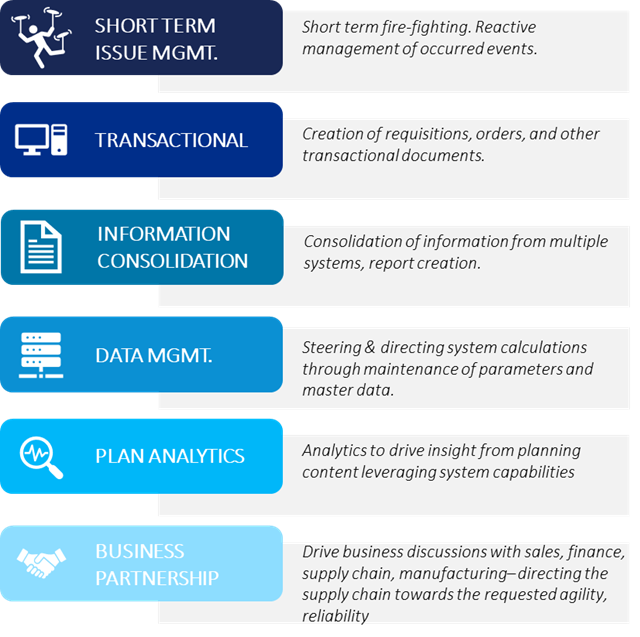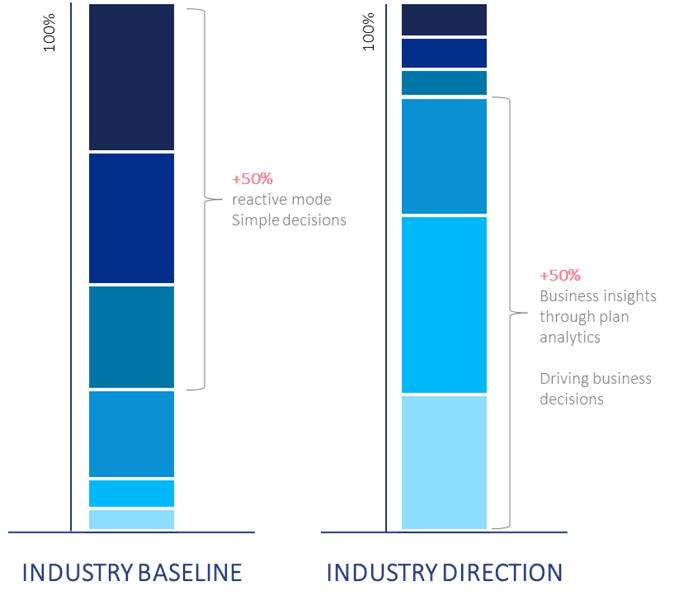
3 ways to navigate your people & planning organization through the digital wave
Supply chain digital transformations—such as APS transformations—are creating a multitude of opportunities in terms of inventory reduction, service improvement, etc. However, they also put increased expectations on your planners. In all the activities we see planners executing today as a result of the supply chain digital transformation, the focus is (finally) fundamentally shifting.

Toward a pro-active environment
In today’s environment, the majority of a planner’s time is spent on reactive planning, short-term issue management and ensuring transactional data is created. Way too often, planners are still the “machine” for consolidating inventory information among different product categories, ECC systems, etc. The reality is that a lot of these decisions are “simple,” (as described in the Cynefin framework) and can be automated.
Gradually, we are seeing organizations move to an environment where planners are proactively creating insight through improved input and are orchestrating risk-based decision-making with their business partners.

The “multi-hat”problem
Important to recognize, however, is that all these various activities require a completely different skillset, often not found in a single planner. At Bluecrux, this is what we call the “multi-hat problem.”
Planners are expected to have a wide range of skills:
- To be a good business partner and orchestrate risk-based decision-making they require strong communication & engagement skills.
- To ensure a good operational plan they need to be precise, accurate and have great system affinity.
- To provide data input to steer heuristics, solvers and advanced models they need to master complex data inputs, be accurate and all in all have a passion for data.
- To create insight, they need to be able to bring advanced analytics to the table, which requires an analytical mindset, and potentially, even strong configuration skills.

Trying to find planners who master these skills with equal success is like looking for a five-legged sheep (or, more traditionally, a needle in a haystack). Finding those extra-limbed sheep or lost needles probably isn’t impossible, but putting your money on it seems like a long shot.
A good example would be MEIO, or multi-echelon inventory optimization. Planners are expected to run the optimization models inclusive of collecting complex input data such as variability on end-to-end lead times, and to interpret and implement the new data, but only after a thorough business discussion with financial, commercial and demand planners, and other stakeholders. These planners are clearly asked to wear too many hats.
While in the demand planning space, companies already thought like this in the past, we see that this trend is now also moving to the supply space. Together with our customers, we have worked out models to crack the multi-hat problem, allowing people to retain a focus.
Navigating the supply chain digital transformation
Overall—whether in the pharma or the broader life science industry—the structures of the past are reaching their limits. Therefore, we want to provide three takeaways for people on their digital planning journey (*):
- Dare to change: Digital transformations yield most in reshaped organizations, which is hard work. Make sure you don’t hollow out your business case and fundamentally add organizational work to your APS transformation.
- Manage the sequence of your organizational transformation and start with the organizational and people work: Organization > Process > System. However, don’t be fooled, and remember that people transformation is a continuous process and requires continuous investment.
- Crack the multi-hat problem and differentiate your expectations in terms of skills for each individual: Find an operating model that uplifts your organization’s skills, without putting all the pressure on five-legged sheep.
(*) As featured in our January #bluecruxtalks webinar session on building digital-ready people and organizations.
So, are you ready to crack your multi-hat problem together? Get in touch & let’s discuss your challenges!

